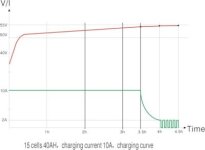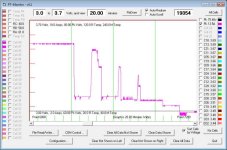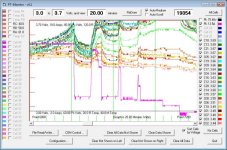Our charger is a Thunder Sky TSL60-15. It's a 'too smart' charger designed to mimic a CC/CV charge curve overall, but it will adjust charge rates based on pack voltage. At the end of the traditional CV phase it starts to 'pulse' to balance the cells. The 'pulses' are quite slow - on for 2 minutes pushing somewhere between 1.4 and 2A, then off for 18 minutes. Here's the curve from Thunder Sky:

Here's how the charger actually stepped the current down after the 'pack average voltage' peaked:

This isn't the typical CV phase where current gently decays, is it?
But what happens to cell voltages as the charger 'slows down'? Here's the pack during the above charger 'step-down':

Wuh-oh. Where did our cells go? Yeah - off the charts. Let's adjust the scale a bit and see what happened.

At the peak, our top cell hit about 3.96V. [edit] Keep in mind that this charger is set for 3.62V per cell - yet cells are pushed well above that... [/edit]
Look at the cells left from the red arrow to the next voltage 'peak'. The full cells were being pushed up with a 2A charge, but the lower cells were still staying 'flat' - they were still soaking up as much energy as they could. These might be our higher capacity cells. They might also be the cells that started the day at a lower SoC. We don't know why they're not fully charged, but we know they're not done yet. Unfortunately for them, the charger's done. They won't be fully charged this time around.
Cell voltage will drop as the cell sits after a charge. The A123 cylindrical cells will hold a surface charge until it's damaged, but most other cells will not hold a surface charge and will bleed down once the charger is disconnected.
Remember in the last section when we looked at the charge curve? We saw that a full cell will have a voltage jump when hit with a charger, but a not-quite-fully-charged cell won't.
Let's look at the voltage decay and the effect from the first 2A for 2 minutes pulse from the charger:

Just before the pulse our lowest cell was at 3.33V and the bottom six cells are below 3.40V. At the peak near the end of the pulse our high cell hit 3.73V. This was only a 1.2A pulse.
Let's look at the effects of nearly four hours of 'pulse and glide' mode on the pack. Do these pulses give us enough energy to bring our stragglers up?

I'm thinking the answer is 'NO' here...
The charger hit the pack with a quick 13A on pulse three. It pushed our high cell up to 3.98V but our stragglers stayed in the mid-3.x range.
Clearly the 'Naked' pack has nothing to keep cells from being pushed over my 3.7V comfort zone (the horizontal red line in the charts). And there's nothing here to help the low cells get topped.
When I step into the garage after this charge, I see a pack voltage in the low 70s, the charger is off. Everything looks good - let's go ride! One thing I don't know by looking at the gauges next morning is that I had cells pushed to nearly 4v overnight. Another thing I don't know is that 1/3 of my pack isn't fully charged. This will likely shorten my ride. And because I'm relying on the controller's low-voltage cut-off of 52.5V (2.5V per cell average), my low cells might not be very happy at the end of the day...
Andy








